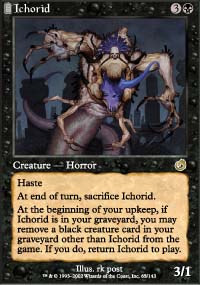

Many of the cards that other dredge versions use are usable in this deck. You also want as many Dread Returns as possible so you can reanimate them early and often. They include, but are not limited toĪs a rule you should have several creatures that draw cards when they come into play (river kelpie, Sphinx of lost truths etc) and at least on finisher in the deck (Iona, Flame kin zealot). Cabal Therapy and Dread Return are particularly good at making tokens with this when you have multiples in your graveyards.ĭread Return: There are a host of creatures available to you to use with this. This means we can stack the Nether Shadows at the bottom of each dredge pile.īridge from below: be careful when attacking or blocking to make sure you don't exile this card. Also remember that in legacy we have to keep our graveyards in the order they are created however when we dredge each pile that comes off the top of our decks goes into the graveyard simultaneously. Nether Shadow: Remember to bring this out every turn if possible. Narcomoeba: This is the best fodder for Cabal Therapy and Dread Return as it comes into play the turn it is dredged. Ichorid: these should come out ever upkeep, and will help make zombies for you with Bridge from Below. There is a general consensus that this is the weakest card in the deck. Regardless of hate your ways of winning with this deck hinge on making the most of each of the following cards.īloodghast: The card that allows Bloodghast to enter the battlefield is Dakmor Salvage and is the worst dredger in the deck, and each Dakmor Salvage Should only be used once so make the most on your Dakmor Salvage by making sure you're going to either win or stop disaster by dredging it. It's also usually best to open with a gigapede or phantasmagorian since you don't have to commit a dredger to the graveyard until you're ready to draw this way. You can use a draw effect (like street wraith) in response to the graveyard exile, this will let you save the dredger while your graveyard gets nuked. There are several key tricks to maintaining this through instant speed hate like tormod's crypt and ravenous trap. One key advantage to using your discard step as your discard engine is that you misstep pretty much all counter magic in the format and the format has more now than ever. To do this you need eight cards in hand and because of this strategy, you'll always be able to dredge on your draw step and discard at end of turn. The goal of manaless Ichorid is to Draw, Discard, then Dredge, using your natural discard as your discard outlet. These points are so important that I would also only advise to mulligan is if you don't have a dredger. This variant of the deck will always choose to be on the draw over the play(to have 8 cards on turn one and naturally discard), And you should also always have a dredger in your hand. Manaless Ichorid Nicholas Rausch's 1st place SCG Cincinatti (228 Players) This variant increases speed, consistency and reliability of tradional dedge at the cost of losing fate out against a turn zero leyline of the void. Manaless Ichorid in legacy did not begin to take root as a serious archetype until the following list placed. Over a few turns creatures like Narcomoeba and Ichorid came onto the battlefield and are sacrificed to either wreck your opponents hand with Cabal Therapy, or put a game winning creature out with Dread Return all the while making Zombies with Bridge From Below. The deck worked by using the dredge mechanic to grow it's grave yard. The mechanic did not gain an archetype of its own until one block later when dread return was printed in time spiral. The first card featuring dredge to be seen as playable was Life From the Loam and was used in decks like Confinement Aggro Loam and Enchantress. The Dredge mechanic was first printed during the ravnica block on green and black cards and was origonaly considered to be a junk ability.

Many people will have no Idea what's happening when you're playing it and often it will feel like you're playing alone. It wants it's opponent's creatures to live, it's creatures to die, it's deck to go in the graveyard and it wants not to draw cards. People sometimes call Ichorid the "crazy backwards upside down deck".


 0 kommentar(er)
0 kommentar(er)
